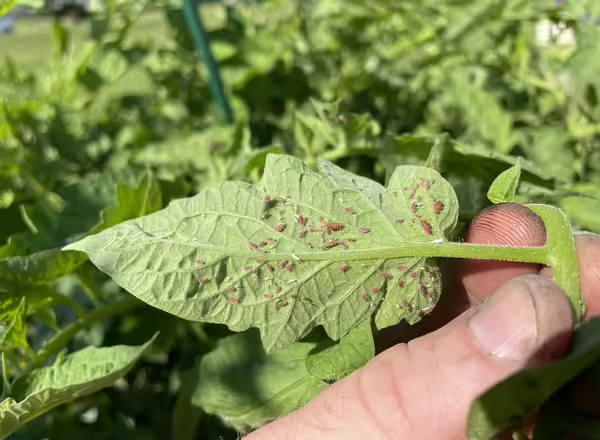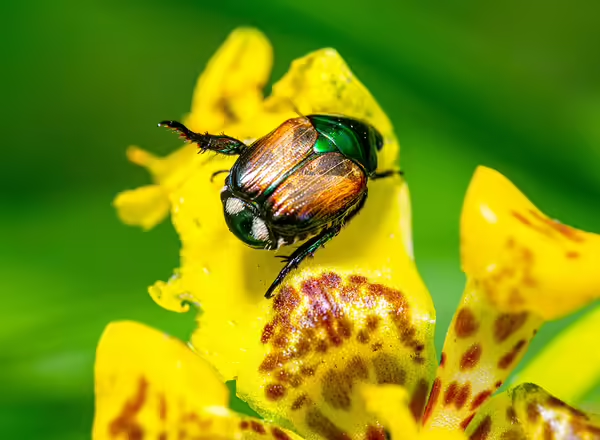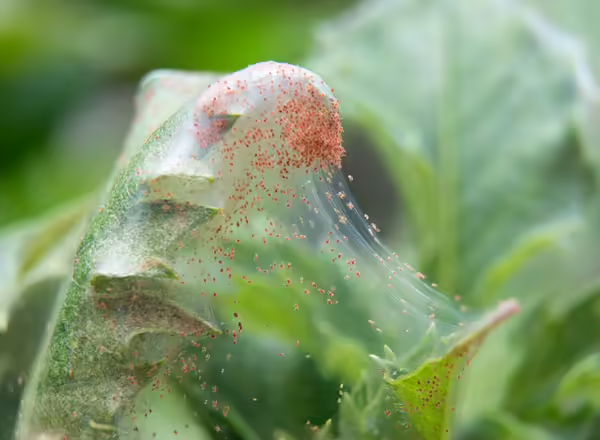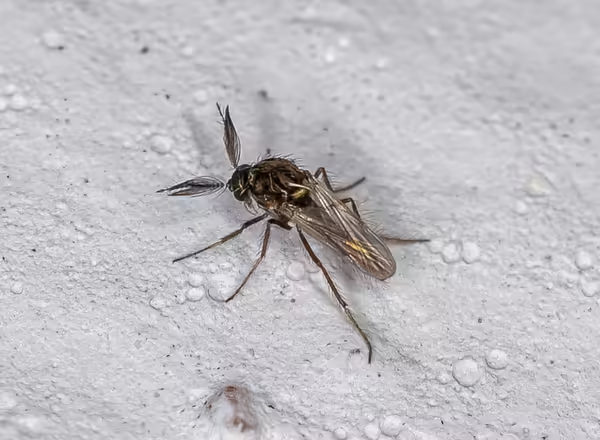Roses are susceptible to a number of disease and insect pests. Roses may survive without a basic pest control program, but they may not be very attractive. A pest control program starts with proper site selection, good soil preparation, good drainage, proper spacing, cultivar selection, and plant maintenance. These all foster healthy roses that are better able to withstand the pressure of disease and insects.
When selecting roses, note the resistance to disease of a particular cultivar or named variety within a class. You want to select by cultivar, not by class. All too often, many gardeners assume that shrub roses (the class) are very tolerant or resistant to disease and make their selection based solely on class. In fact, there are a number of cultivars that are very prone to severe disease injury.
Plants can have two types of resistance: phenotypic or genotypic.
- Phenotypic resistance is when a cultivar is resistant to a disease in one location or part of the country but not in another.
- Genotypic resistance is due to the presence of genes that are not affected by climate, location, or horticultural practice.
That is why, when the term "resistance" is used as a blanket term and assigned to a variety or class, it may or may not apply depending on where you garden.
Diseases
This fungal disease can cause almost complete defoliatiation of bushes by early fall, resulting in a weakened bush on which cane die-back and cankers become severe. Blackspot is identified as circular black spots that appear on the upper surface of the leaves, starting at the bottom of the plant and moving upward. Infected leaves turn yellow and fall off prematurely. The fringed margin and black color distinguish this leaf spot from others. Infections on canes are identified as reddish-purple spots. Splashing water spreads blackspot. Infection occurs after leaves are wet for several hours, making it more serious during rainy periods. Some roses are less susceptible than others, so cultivar selection is important. The fungus overwinters in fallen leaves and stem cankers. Raking and removing these leaves as well as pruning out affected canes by spring before the buds swell may help provide some control. Avoid wetting the leaves when watering and locate plants where there is good air circulation. Fungicide spray programs need to be started as soon as new leaves appear in the spring.
Powdery mildew is a fungus disease that affects young leaves, causing them to curl and twist and develop a purple coloration. As the disease progresses, leaves become covered with white powdery fuzz. Whereas blackspot is usually most severe on the lower part of the plant, mildew affects the top part of the plant. Mature leaves are less likely to be affected. Mildew is spread by wind and develops rapidly during periods of warm, dry days followed by cool, humid nights. Infections of mildew are actually discouraged by the presence of water on the leaves. However, keeping plants wet all night to avoid mildew provides an environment that allows other diseases to develop. Infection can be reduced through sanitation and fungicide spray programs. Prune out all dead and diseased canes to reduce initial fungus infection. Because new growth is especially susceptible, thorough coverage of new growth with fungicide is important. Plant roses in areas where they receive good air circulation and where the foliage can dry off rapidly in the early morning to prevent many types of diseases.
There are several fungi that cause cankers on roses. The different fungi can cause different-looking cankers, but they usually produce brown, oval-shaped, sunken, or shriveled areas anywhere on the cane. The cane dies, and leaves wilt from that point outward. Sometimes small black specks can be seen on the cane surface within the borders of the canker. These are fungal spore-forming structures. Cankers should be pruned out each year. Make the cut well below the affected tissue. Protect the plant from cold or freeze injury by providing adequate cover over the winter. Do not cover roses too early in the fall. When roses are mulched before the soil freezes, moisture can be trapped around the canes and this can increase the damage caused by canker disease. Keep plants vigorous with proper culture and disease control. Canker is a disease of stress. If plants are kept actively growing, they stand a better chance of avoiding cankers. There are no effective chemical controls for canker disease.
Botrytis blight is a fungal disease that generally attacks dying tissue. It is frequently found on older flowers and other plant parts. Under certain conditions it may also attack healthy tissue. Botrytis favors moist, wet conditions, often causing the disease to attack entire flowers and produce a gray fuzzy mold. This disease is often called gray mold. Good garden sanitation and removing spent flowers often result in good control of this disease. When this is insufficient in providing adequate control, a preventative spray program may be necessary.
Rose mosaic is caused by a virus. Bright yellow patterns made up of wavy lines may appear on the leaves of some varieties. Other varieties may show no yellow lines, but may be stunted and weak due to virus infection. Virus-infected plants cannot be cured. Plant virus-resistant roses if possible. Try to control insects, especially aphids, since they help spread the virus. If you are pruning virus-infected plants, don't prune healthy plants unless you first disinfest your pruners. Dipping the blades in a 10 percent solution of chlorine bleach and water for 60 seconds can do this. A 25 percent concentration reduces the time needed to about 10 seconds. All infected plants should be removed and destroyed to reduce the spread of the virus to other plants.
Crown gall is a bacterial disease that can survive 15 to 20 years in the soil. It causes irregularly shaped, rough, dark-colored masses (galls) to appear on stems near the soil line. These galls can appear as small swellings or be several inches in diameter. Severely infected plants become stunted and fail to grow properly. There are no effective controls for crown gall. Severely infected plants should be dug up and discarded and roses should not be planted in that area for at least 5 years. Avoid buying plants with suspicious swellings or gall on lower stems or crowns. However, do not confuse crown gall with normal swellings that you see as a result of the budding process. Protect plants from injury on stems during cultivation. Maintain vigor with fertilization and watering. Crown gall is not specific to roses and can affect apples, raspberries, honeysuckle, euonymus, and many vegetables. For this reason, roses should not be planted where plants susceptible to crown gall have been removed because of the disease. Galltrol-A, a non-pathogenic bacteria, has been used to prevent crown gall. It is often used as a dip on cane root roses prior to planting.
Rose rosette is becoming more common and can result in significant damage. This pathogen (not yet positively identified) is spread by an eriophid mite. Symptoms include rapid growth of shoots, development of "witches' broom," development of tufts of small, deformed reddish leaves and excessive thorniness. Plants decline over time. Because affected plants can't be cured, it is best to dig out the affected plant and destroy it. Controlling the mite has been labeled as an option but attempts at controlling it have proven inconclusive. It is very difficult to apply sprays in a timely and satisfactory way.
Insect Pests
Common insect pests to look out for.

Aphids are very common pests. Aphids are soft-bodied insects that can be red, green, yellow, or black. They feed on very young succulent shoots, causing distortion. Aphids are often kept in check by natural predators. Alternative control measures include the use of insecticidal soaps, strong streams of water to knock them off the plant, or insecticides.

These hard-shelled, metallic-green, black, and gold insects can cause extensive damage to roses just by their sheer numbers and voracious appetite. They prefer flowers and flower buds but will also attack foliage. Japanese beetles are difficult to control because they are strong fliers and constantly reinvade the area. Home gardeners still find that Sevin provides the best control, but it is only topical. This means that reapplication needs to be done on a regular basis to protect the foliage and flowers. Beware of Japanese beetle traps. Traps are almost too effective and will draw a great number of beetles into an area, making the problem worse. If they are used, they should be placed in areas away from the rose garden. Hand picking is also a suggested control for small numbers of beetles.

It is unusual to see the insects at work, but they make their presence known by the perfectly round holes cut near the edges of the leaves. These leaf pieces are used to make egg partitions inside their burrows. The damage they cause is strictly cosmetic and warrants no control.

Mites are very tiny relatives of spiders. They can be red, black, or brown in color. Mites pierce the underside of rose leaves and suck sap, causing the leaf to turn gray or bronze. A fine web is a sign of a heavy infestation. Mites reproduce rapidly, resulting in high populations in a short time. Mites flourish in crowded, stagnant gardens. A high-pressure washing with water from a garden hose directed to the underside of the leaves every 2-3 days can manage mites. This will interrupt their life cycle. Miticides such as dicofol help in heavy infestations. Insecticidal soaps are also effective in controlling mites.

Thrips are extremely small, brown insects usually living and feeding inside of the blooms. A deformed flower with flecked or scratched petals is usually a sign of a thrips problem. The rasping mouth parts of thrips causes this injury when they scratch the petal surface to feed. Thrips are especially attracted to yellow or light-colored roses. Some control can be achieved using materials such as orthene, malathion, or insecticidal soap, but even these often give poor results. They tend to be worse during late June, July and August when temperatures are warm.

The rose midge is a tiny fly that lays eggs in the buds and shoots of roses. The larvae that develop start feeding and causes bent, mishapen or blasted flower buds and withering of the stem tips. Eventually they turn black. Control consists of pruning out buds and applying insecticide if the problem persists. Midge damage usually shows up in July. Because the larvae fall to the soil to pupate, an effective control is to place weed barrier fabric under the plants to catch the larvae and prevent them from entering the soil to pupate.

The common rose slug causes skeletonizing or window pane like damage to rose leaves in spring and early summer. The larvae look like caterpillars but are actually more closely related to bees and wasps. Common rose slugs are green with a light tan head and often have may hairlike bristles. Although they look like caterpillars, products with a BT are not effective because they are not larvae of moths or butterflies. Control can include hand picking and the use of horticultural oils or insecticidal soaps.
Fungicide Spray Programs
Before applying any type of insecticide, accurately identify the problem. Because pest control materials change, it is strongly suggested to consult the most current edition of University of Illinois Extension Pest Management for the Home Landscape for current pest control suggestions, both chemical and non- chemical.